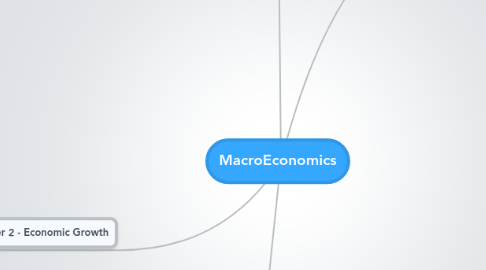
1. Chapter 1 - MacroEconomics
1.1. Macroeconomic Goals
1.1.1. Economic Growth
1.1.2. Low Unemployment
1.1.3. Low Inflation
1.2. Macroeconomic Performance
1.2.1. Increase economy's output
1.2.2. Trend Outputs
1.2.3. Positive/Negative Output Gaps
1.3. Conflict of Objectives
1.3.1. Output Gaps
1.3.2. Economic Growth
1.3.3. Recession
1.3.3.1. Real Output falls over two consecutive quarters
1.3.4. Unemployment
1.3.5. Inflation
1.3.5.1. Cost Push
1.3.5.2. Demand Pull
1.4. Circular Flow of Income
1.4.1. Agents of the Economy
1.4.1.1. Firms
1.4.1.2. Households
1.4.2. Monetary Flow
1.4.2.1. Incomes
1.4.2.2. Expenditures
1.4.3. Real Flow
1.4.3.1. Factors of Production
1.4.3.2. Goods and Services
1.4.4. Aggregate Demand change
1.4.4.1. Savings (withdrawal)
1.4.4.1.1. W = Savings + Taxes + Imports
1.4.4.2. Investment (injection)
1.4.4.2.1. J = Investment + Gov. Spending + Exports
1.4.5. Disequilibrium
1.4.5.1. Investment ≠ Savings
2. Chapter 2 - Economic Growth
2.1. OverView
2.1.1. National Output = National Expenditure = National Income
2.1.2. GNP = GDP + net property income from abroad
2.2. Real And Nominal Values
2.2.1. Real
2.2.1.1. Inflation Adjusted figures
2.2.2. Nominal
2.2.2.1. Current figures
2.3. Economic Growth
2.3.1. 'Increase in potential level of output over time'
2.3.2. Increase in productive capacity
2.3.2.1. Supply Side Policies
2.3.3. Percentage change in real GDP
2.3.4. Types of Economic Growth
2.3.4.1. Short Run
2.3.4.1.1. Uses spare capacity (on PPF)
2.3.4.2. Long Run
2.3.4.2.1. Increase total capacity (on PPF)
2.4. AD/AS Analysis
2.4.1. Demand Side Policies
2.4.1.1. Fiscal Policy
2.4.1.1.1. Change Taxes
2.4.1.1.2. Change Gov. Spending
2.4.1.2. Monetary Policy
2.4.1.2.1. Change Interest Rates
2.4.1.2.2. Change Money Supply
2.4.1.2.3. Change Exchange Rate
2.4.2. Aggregate Demand change
2.4.2.1. AD=C+I+G+(X-M)
2.4.2.1.1. A change in any of these components results in a change of aggregate demand
2.4.2.2. Change in price level results in a change of Aggregate Demand
2.4.3. Aggregate Supply change
2.4.3.1. As price level changes, so does the amount of Aggregate Supply
2.4.3.2. Potential rise in costs of production
2.4.3.2.1. Overtime payment
2.4.3.2.2. Inefficient old machinery costs
2.4.4. AD/AS Diagram
2.4.4.1. Rightward Shift in AD
2.4.4.1.1. Positive Output Gap
2.4.4.2. Leftward Shift in AD
2.4.4.2.1. Negative Output Gap
2.5. Index Numbers
2.5.1. Index number = (Number in current year/number in base year) x 100
2.5.2. Useful to compare two sets of figures
3. Chapter 3 - Unemployment
3.1. Defining Unemployment
3.1.1. Definition - A member of the population of the working age, out of work and actively seeking employment
3.1.2. Measured by claimant count and Labour Force Survey
3.1.2.1. Claimant count is number of people claiming unemployment benefits
3.1.2.2. Labour Force Survey is surveying the amount of people who are working and amount looking for work
3.1.3. Full employment = number of people wishing to work = number of people wish to hire (all at market real wage rate)
3.2. Causes of Unemployment
3.2.1. Cyclical Unemployment
3.2.1.1. Negative output gap, so downturn in Aggregate Demand, so employers lessen costs by making workers redundant
3.2.2. Structural Unemployment
3.2.2.1. Structure of economy changes,
4. Aggregate Demand And Spending
4.1. Consumer
4.1.1. Decline in Employment
4.1.2. Bad Markets ie House Prices
4.1.3. Low interest rates
4.1.4. Tax Cuts
4.2. Investment
4.2.1. Tax Cuts
4.2.2. Low Interest Rates
4.2.3. Low confidence
4.2.4. Banks tighter on loan criteria
4.3. Government Spending
4.3.1. High levels of debt
4.3.2. Tax Revenues
4.3.3. High unemployment benefits
4.4. Saving
4.4.1. 35% don't save
4.4.2. Low interest rate - no incentive
4.4.3. 50% not saving for pension
4.4.4. Invest in banks - not home
